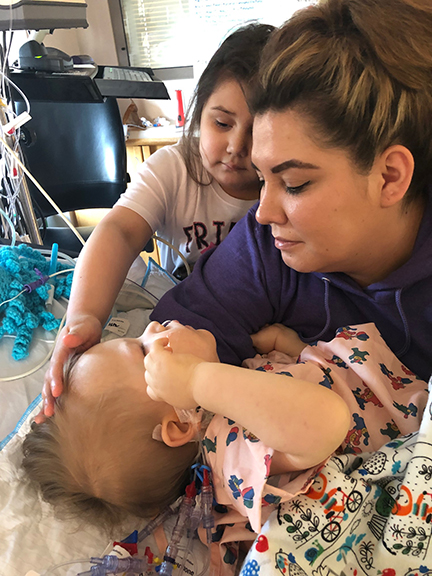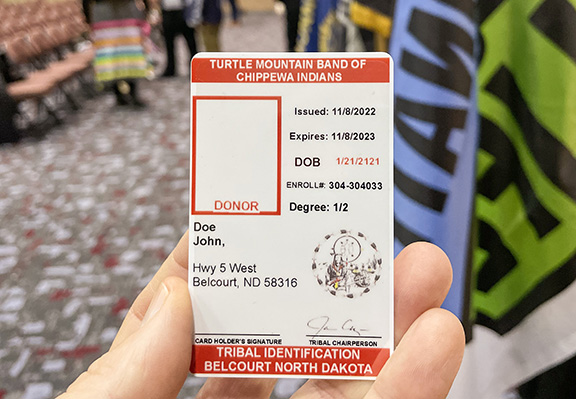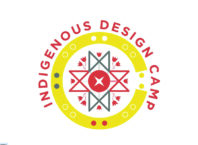
By Sarah Sonn
On November 14, 2022, the Turtle Mountain Band of Chippewa of Belcourt, North Dakota became the first tribe in the United States to offer organ donor registration through their tribal identification cards.
“Today is a monumental day that people will remember, especially Native nations, for decades to come,” Turtle Mountain Tribal Chairman Jamie Azure said at an event to launch the ID initiative.
Known as the “The Greyson Initiative,” the effort was led by tribal member Joan Azure in partnership with LifeSource, the non-profit organization who manages the organ, eye and tissue donation for the Upper Midwest. Joan Azure was familiar with organ donation through her career as the Director of Quality Assurance at Quentin Burdick Memorial Healthcare, but organ donation became personal when her seven-month-old grandson, Greyson, needed a heart transplant.
A need for more organ donors
As of January 2023, there are nearly 3,000 people across Minnesota, North Dakota and South Dakota waiting for a life-saving transplant. Of those, 142 identify as Native American/Alaskan Native. Every nine minutes, across the country, someone dies waiting. There simply aren’t enough organs to meet the need.
Only about 20 percent of people who identify as Native American say “yes” to donation when approached in the hospital, compared to 60 percent of people who identify as white. While race and ethnicity aren’t required to match for successful transplantation, it helps, especially with rarer blood types required to match.
Directed donation is also an option, which involves identifying a specific person to donate to when you pass away. You can include instructions in a living will or advanced directive, or your family can make that request at the time of your passing.

A case for tribal donor registration
Right now, the primary mode of registration as an organ, eye and tissue donor is on a driver’s license or state ID. However, on average, only 56 percent of people in the upper Midwest have “DONOR” on their driver’s license.
After seeing a heat map of registration rates across North Dakota – with the lowest rates corresponding with tribal lands – Joan Azure had the idea around adding the option to tribal identification documents.
The Greyson Initiative would provide the opportunity for Turtle Mountain Band of Chippewa tribal members who don’t have a state ID.
Checking the “DONOR” box honors Greyson
Although Greyson’s time on earth was short, he left a profound legacy on his family, his tribe and the entire country though this initiative.
“So when you check the box, remember the little boy with the black-rimmed glasses who smiled through every hardship,” said Joan Azure to her fellow tribal members. “By doing this, we’re honoring him. And we’re keeping him alive so to speak. Now with people checking the box, they’re going to save lives. And that’s what his legacy is all about.”
Many lives will be saved because of Greyson’s story and his grandmother, Joan’s, passionate advocacy.

How organ donation works
Becoming an organ donor is extremely rare. A potential organ donor must experience a life-ending injury and pass away at a hospital while connected to a ventilator that is keeping the organs functioning artificially.
After a hospital has exhausted all possibilities to save a patients’ life, they call LifeSource to perform testing and medical evaluations. Then, someone from LifeSource talks to the patient’s family about donation. If the person was a registered donor, LifeSource will honor those wishes and move forward with donation. If the patient was not registered, the next of kin is asked to decide on their behalf.
If one or more organs is deemed viable for transplant, details from medical tests are put in a database under an anonymous identifier. The database matches the donor with the safest recipients based on blood type, tissue type, need and location. The sickest recipients are listed first.
Once recipients are located, the recipient’s surgeons travel to the donor’s hospital to perform the recovery surgery. Often, an “honor walk” is performed for the patient where hospital staff line the hallway leading to the operating room. When the surgery is over, those surgeons return to their transplant center with the recovered organ to perform the transplant surgery.
To learn more, visit https://www.life-source.org.






